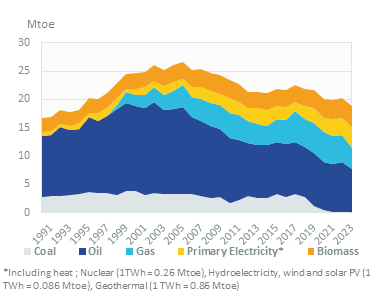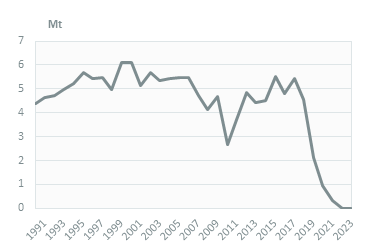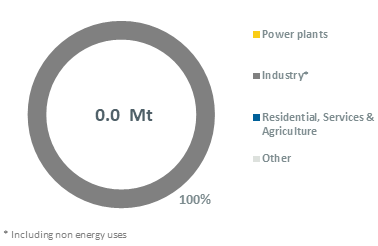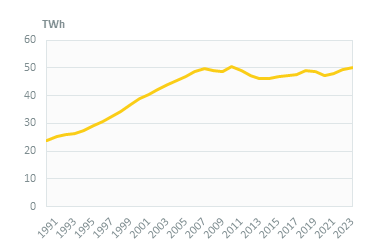-
-
 Energy and Climate Databases
Energy and Climate Databases- The most comprehensive and up-to-date annual energy database.
- Monitoring of technology providers in H2 supply chain.
- Monthly energy data on key energy markets.
- The most reliable and up-to-date power generation database.
- The essentials of LNG trade at your fingertips.
- Global monitoring of new and existing refineries.
- Analyse energy consumption and efficiency trends at world level. Benchmark countries.
- Have your database developed by a recognised expert of both energy and IT.
-
 Energy - Climate Forecasts
Energy - Climate Forecasts- Instant access to energy and emissions forecasts.
- Strategic, annual wholesale price projections backed by Enerdata's energy modelling expertise and our globally recognised POLES model.
- Wedges module showing a breakdown of the levers enabling to reduce emissions between two scenarios.
- Unique, independent projections of consumption by end-use.
- GHG Marginal Abatement Cost Curves.
- Benefit from proven models to draw your own energy scenarios and anticipate tomorrow’s challenges.
-
 Market Intelligence
Market Intelligence- 110 Energy and climate country reports
- A newsletter to receive the latest updates on evolving technologies and policies.
- Global energy news and analyses curated daily.
- Enerdata’s experts bring you the essentials about your market and competitors.
-
-
-
 Market Analysis
Market Analysis- Understanding key consumption trends and drivers across sectors.
- Granular and exclusive insight to address the most pressing business and strategic issues.
- Expertise in strategic and business intelligence, with fine-tuning to the market’s specificities.
-
 Energy - Climate Scenarios
Energy - Climate Scenarios- Providing the outlook of an energy commodity in mid to long term time horizons.
- Sector and driver specific energy demand forecasting.
- Assess the evolution of energy prices on the international and regional markets, as well as end-users prices.
- Enerdata guides you through pathways to reach climate targets.
- Supporting local authorities in their decarbonisation strategies.
-
 Climate Strategy and Policy Evaluation
Climate Strategy and Policy Evaluation- Cutting-edge quantitative tools and relevant indicators to monitor and evaluate evolutions on worldwide energy markets.
- Analysis of the most cost-effective options to reduce emissions.
- Quantified simulation and analysis of pledges for climate change negotiations.
- Breakdown of carbon markets and evaluation of the climate change impacts on the carbon price.
- Enerdata guides you on the most beneficial policy or investment options.
- Turning climate objectives into concrete action plans.
-
 Training
Training- Understand different policy targets and measures on energy efficiency.
- How to measure energy savings?
- Energy Forecasting is a 2 days training to learn to design and interpret energy forecasts.
- Energy statistics training allowing to create energy balance with supply, transformation and consumption and understanding the international energy statistics regulations.
- Initiation to EnerMED level 1is the training to approach on the most powerful energy demand forecasting model.
-
-
Resource Centre
Portugal Key Figures
- Population:
- 10.4 million
- GDP growth rate:
- 6.69 %/year
- Energy independence:
- 27.4%
Data of the last year available: 2022
- Total consumption/GDP:*
- 72.4 (2005=100)
- CO2 Emissions:
- 3.74 tCO2/capita
- Rate of T&D power losses:
- 8.83%
* at purchasing power parity
View all macro and energy indicators in the Portugal energy report
Portugal Energy News
View all news, archive your new and create your own daily newsletters only on your topics/countries of interest with Key Energy Intelligence
Portugal Energy Research
Benefit from up to 2 000 up-to-date data series for 186 countries in Global Energy & CO2 data
A data overview is available in the global energy statistics app
Portugal Total Energy Consumption
Consumption per capita is 28% lower than the EU average at 2.1 toe, 4 780 kWh of which is electricity (14% below the EU average) (2022).
Graph: CONSUMPTION TRENDS BY ENERGY SOURCE (Mtoe)

Total energy consumption rose by 8.2% in 2022 to 21.8 Mtoe, after a 7.4% decline in 2020 and stagnation in 2021. Previously, it declined by 3%/year between 2005 and 2012 with the economic recession and increased slightly between 2012 and 2017 (+1.2%/year).
Interactive Chart Portugal Total Energy Consumption
Benefit from up to 2 000 up-to-date data series for 186 countries in Global Energy & CO2 data
View the detailed fondamentals of the market at country level (graphs, tables, analysis) in the Portugal energy report
Portugal Crude Oil Production
Portugal does not produce oil and imported 12 Mt of crude oil in 2022 (+10% compared to 2021). In 2022, the main crude oil suppliers were Brazil (38%), Nigeria (14%), Algeria (11%), and Azerbaijan (11%).
The country produced 12 Mt of oil products in 2022 (+7.1%). Portugal has a refining capacity of 230 kb/d at the Sines refinery in Porto; in 2023, the refinery reduced its production due to maintenance works. The Matosinhos refinery (110 kb/d, also in Porto) was shut in down in 2020. Portugal is a net exporter of oil products (3.6 Mt exported vs 3.5 Mt imported in 2022).
Interactive Chart Portugal Crude Oil Production
Benefit from up to 2 000 up-to-date data series for 186 countries in Global Energy & CO2 data
Additionally, for more detailed information on refineries, you can request a sample of our EMEA Refineries Dataset
Portugal Oil Products Consumption
Oil product consumption increased by 16% in 2022 to 9.6 Mt, after fluctuating since 2017. Before that, it had remained roughly stable at around 9 Mt between 2013 and 2017 and decreased rapidly between 2005 and 2012 (-7%/year) especially for industry and power plants (10%/year and -20%/year, respectively).
The transport sector is the largest oil consumer (57% in 2022), followed by industry (20%, including non-energy uses), buildings and agriculture (9%), and the hydrocarbon industry (8%).
Graph: OIL CONSUMPTION (Mt)
Interactive Chart Portugal Refined Oil Products Production
Benefit from up to 2 000 up-to-date data series for 186 countries in Global Energy & CO2 data
Additionally, for more detailed information on refineries, you can request a sample of our EMEA Refineries Dataset
Portugal Natural Gas Consumption
Gas consumption has been decreasing since 2019 (COVID-19 pandemic in 2020, high prices in 2021 and 2022) to 5.6 bcm in 2022. It increased rapidly between 2014 and 2019 due to an increase in demand from power plants, partly because of lower hydropower availability.
The share of gas used for power generation has been fluctuating between 62% and 45% since 2010 (62% in 2022), depending on hydropower availability. Industry accounts for 21% of total gas consumption and buildings for 10%.
Graph: NATURAL GAS CONSUMPTION (bcm)
Interactive Chart Portugal Natural Gas Domestic Consumption
Benefit from up to 2 000 up-to-date data series for 186 countries in Global Energy & CO2 data
Additionally, for more detailed information on the LNG trade, you can request a sample of our EMEA LNG Trade Dataset
Portugal Coal Consumption
Coal consumption stopped in 2022. It had dropped drastically from a level of 5 Mt in 2017. Previously, coal consumption was almost entirely used for power generation and its consumption levels depended on hydropower generation and price spreads with gas.
Graph: COAL CONSUMPTION (Mt)

Graph: COAL CONSUMPTION BREAKDOWN BY SECTOR (2022, %)

Interactive Chart Portugal Coal and Lignite Domestic Consumption
Benefit from up to 2 000 up-to-date data series for 186 countries in Global Energy & CO2 data
View the detailed consumption trends at country level (graphs, tables, analysis) in the Portugal energy report
Portugal Power Consumption
Electricity consumption has been increasing slightly since 2012, reaching 50 TWh in 2022 (its 2010 level). Since 2014, electricity consumption has increased by around 1%/year.
In 2022, industry is the largest electricity consumer, with 34%, followed by services (31%) and households (30%).
Graph: ELECTRICITY CONSUMPTION (TWh)

Graph: ELECTRICITY CONSUMPTION BREAKDOWN BY SECTOR (2022, %)
Portugal Renewable in % Electricity Production
ADENE is also the national agency responsible for renewables.
Portugal's updated NECP set a new target for a 49% contribution of renewables' in final energy consumption in 2030 (up from 47% previously), increasing its goals from 80% to 85% for electricity, from 38% to 47% for heating and cooling, and from 20 to 23% in transport. The target for 2020 was exceeded by 3 points, with an actual share of 34%. In 2021, the share of renewables remained at 34% (58.5% for power, 42.7% for heating and cooling, and 8.6% for transport).
Interactive Chart Portugal Share of Renewables in Electricity Production (incl hydro)
Benefit from up to 2 000 up-to-date data series for 186 countries in Global Energy & CO2 data
Learn more about renewables in the European Battery Market Analysis
Portugal CO2 Fuel Combustion/CO2 Emissions
GHG emissions have fluctuated around 65 MtCO2eq since 2021, with a peak at 71.5 MtCO2eq in 2017 due to large forest fires. Emissions have decreased since then, reaching 56.5 MtCO2eq in 2021. Before that, emissions had decreased steadily by 3.3 %/year from 2005 (86 MtCO2eq) to 2014 (64MtCO2eq).
The draft update of the NECP (June 2023) aims to reduce emissions (without LULUCF) by 55% in 2030 compared to 2005 levels (from 45-55% in the previous NECP). It also brings forward the carbon neutrality target from 2050 (Roadmap for Carbon Neutrality 2050, RCN 2050) to 2045.